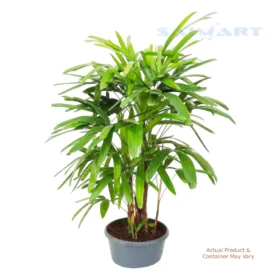- Your cart is empty
- Continue Shopping
Plumeria (Champa) Plant
₹100.00Current price is: ₹100.00. Original price was: ₹180.00.
| About this product |
| Plumeria, commonly known as Champa, is a tropical and subtropical flowering plant revered for its vibrant and fragrant blossoms. Belonging to the Apocynaceae family, this plant is native to Central America, Mexico, and the Caribbean but has found its way to various tropical regions worldwide. Plumeria is renowned for its beautiful, waxy flowers and distinctive fragrance, making it a popular choice for gardens, landscapes, and ceremonial decorations. |
| For landscaping & garden renovation services, please contact us |

Product Description
| Plant Overview |
| Plumeria, commonly known as Champa, is a tropical and subtropical flowering plant revered for its vibrant and fragrant blossoms. Belonging to the Apocynaceae family, this plant is native to Central America, Mexico, and the Caribbean but has found its way to various tropical regions worldwide. Plumeria is renowned for its beautiful, waxy flowers and distinctive fragrance, making it a popular choice for gardens, landscapes, and ceremonial decorations. |
| Plant Benefits |
| 1. Aesthetically Pleasing: The Plumeria plant is celebrated for its visually stunning and fragrant flowers, which come in a variety of colors, including white, pink, yellow, and red. Its blossoms are often used in making leis and are associated with tropical beauty.
2. Fragrance Therapy: The intoxicating fragrance emitted by Plumeria flowers is not only delightful but also possesses aromatherapeutic qualities. The scent is believed to have a calming effect, promoting relaxation and reducing stress. 3. Low Maintenance: Plumeria is relatively easy to care for, making it an ideal choice for both experienced and novice gardeners. With proper care, it can thrive in diverse climates, provided it receives adequate sunlight and well-drained soil. 4. Symbolism and Cultural Significance: Plumeria holds cultural significance in many tropical regions, symbolizing love, beauty, and spirituality. In various cultures, the flowers are used in religious ceremonies, weddings, and other important rituals. 5. Medicinal Uses: Some traditional medicinal practices incorporate Plumeria extracts for their potential antibacterial and anti-inflammatory properties. However, it’s important to note that any medicinal use should be approached with caution and under professional guidance. |
| Plant Care Tips |
| 1. Sunlight: Plumeria thrives in full sunlight. Ensure it receives at least 6 hours of direct sunlight daily for optimal growth and flowering.
2. Soil and Watering: Plant Plumeria in well-draining soil and water it sparingly. Allow the soil to dry out between watering sessions to prevent root rot. 3. Fertilization: Use a balanced fertilizer with higher phosphorus content to encourage flower production. Apply during the growing season, typically spring and summer. 4. Pruning: Prune Plumeria to shape it and encourage branching. Remove dead or damaged branches to promote overall plant health. 5. Winter Care: In colder climates, protect Plumeria from frost by moving it indoors or providing adequate insulation. Reduce watering during the dormant winter months. |
| Ideal Plant Placement |
|
| Significance of This Plant |
|
| FAQs |
|
|
| Disclaimer |
| Every effort is made to maintain accuracy in our product information, yet variations in packaging, information, instruction and materials may occur. We advise against solely relying on the provided details. If a product is unavailable, rest assured that a prompt full-refund will be initiated for the paid amount, ensuring transparency and customer satisfaction in every transaction. |

Additional Information
| Plant Size | 1 – 2 Feet |
|---|
Only logged in customers who have purchased this product may leave a review.






Reviews
There are no reviews yet.